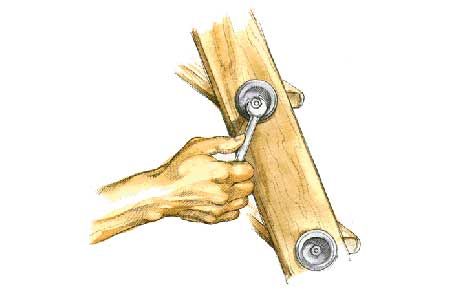Wobbly ladders are a nuisance that can pose serious safety risks. Whether you’re a do-it-yourselfer (DIYer) or a homeowner tackling routine maintenance, this guide walks you through how to identify, repair, and prevent loose ladders.
Common Causes of Wobbly Ladders
Understanding the root causes of ladder instability is the first step to completely fix the issue. Problems may arise from various issues, such as wear and tear, loose hardware, or physical damage. Here are the most common causes.
Age-Related Wear and Tear
As ladders age, they naturally experience wear and tear from regular use. This can lead to loosening joints, weakened materials, and overall decreased stability. Wooden ladders, in particular, are susceptible to environmental factors that can accelerate deterioration. Humidity, temperature fluctuations, and UV exposure can all contribute to the weakening of wood fibers, making the ladder less reliable over time.
Loose Hardware
One of the most common and easily fixable causes of ladder wobbliness is loose hardware. Over time, the nuts and bolts that hold the ladder together can loosen. This makes it less stable. Regularly checking and tightening these components can prevent minor issues from becoming larger problems.
Damaged Components
Physical damage to ladder components, such as bent rails or cracked rungs, can significantly impact stability. These issues may result from improper use, accidents, or poor storage practices.
Tools Needed for Ladder Repair
Before attempting any repairs, gather these basic tools:
- Adjustable wrench
- Screwdriver set
- Pliers
- Measuring tape
- Safety glasses
For more advanced repairs, you might need additional tools and materials.
- Paint or varnish (for touch-ups)
- Replacement hardware (if needed)
- Sandpaper
- Wood glue (for wooden ladders)
Assessing Your Ladder’s Condition
First, thoroughly assess your ladder’s condition. This will help you determine whether a repair is feasible or if you need a new ladder altogether.
Safety Inspection Checklist
Use the following checklist to guide your ladder inspection:
- Check all rungs for cracks, splits, or excessive wear.
- Inspect side rails for bends, cracks, or splinters.
- Examine all joints and connections for looseness.
- Look for signs of rust or corrosion on metal components.
- Test the ladder’s overall stability on a level surface.
When To Replace vs. Repair
If your ladder shows signs of severe structural damage, such as multiple cracked rungs or bent side rails, it’s likely time for a replacement. However, if the issues are limited to loose hardware or minor wear, repairs are often possible and cost-effective. Always prioritize safety, and consult a professional if you’re unsure whether your ladder can be safely repaired.
Step-by-Step Guide to Tightening Ladder Braces
For many wobbly ladders, tightening the metal braces can make it stable. Follow these steps to tighten loose hardware.
Step 1: Locating the Hex Nuts
Begin by finding the hex nuts on the outside of the ladder rails. There should be one at each rung, securing the metal braces in place. Make a note of any rusted or stripped nuts that you may need to replace.
Step 2: Proper Tightening Technique
Using an adjustable wrench, carefully tighten each hex nut. Work methodically from top to bottom, giving even pressure across all connections. Apply steady pressure to avoid stripping the nuts or damaging the rails.
Step 3: Testing Stability After Adjustments
After tightening all nuts, place the ladder on a level surface and test its stability. If it still wobbles, repeat the tightening process, paying extra attention to any areas that feel loose. For added safety, ask someone to help you stabilize the ladder while you make adjustments.
Additional Methods to Improve Ladder Stability
Beyond tightening hardware, there are other ways to improve your ladder’s stability and safety.
Adding Nonslip Feet
Installing nonslip feet or replacing worn ones can significantly improve ladder stability, especially on smooth surfaces. These attachments provide better traction and help prevent slipping accidents. They are often made of rubber or similar materials that grip well on many surfaces.
Reinforcing Weak Points
For wooden ladders, reinforcing weak joints with wood glue and clamps can add strength. Follow the manufacturer’s instructions for any adhesives used. For metal ladders, consider replacing any visibly worn or damaged components with manufacturer-approved parts. This helps with compatibility and maintains the structural integrity of the ladder.
Using Ladder Levelers
You can attach ladder levelers to the feet of the ladder to provide a level base on uneven ground. They’re especially useful for outdoor projects where the ground likely isn’t flat. Make sure the levelers are securely attached and test the ladder for stability before climbing up.
When To Call a Professional To Fix Your Ladder
While many ladder repairs can be DIY projects, some situations call for professional assistance. If you’re unsure about the extent of damage or lack the tools and experience for complex repairs, contact a pro, like a handyperson. This is especially important for specialized ladders or those used in commercial settings. Professionals have the knowledge and access to replacement parts that may not be readily available to consumers.
Our Conclusion
A wobbly ladder is more than just an inconvenience—it’s a safety hazard that absolutely needs attention. By following this guide, you can often restore your ladder to a safe, stable condition. Remember, regular maintenance and proper use are key to preventing future issues.
If your ladder is still unstable after tightening all the hardware and attempting basic repairs, we recommend getting a replacement or consulting a pro repair person. Safety should always be your top priority when working at heights. A new, stable ladder is a worthwhile investment in your safety and peace of mind for all your future projects.

